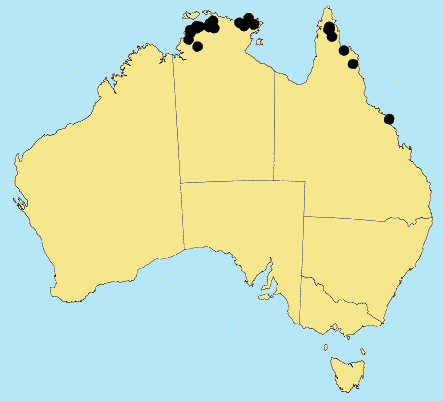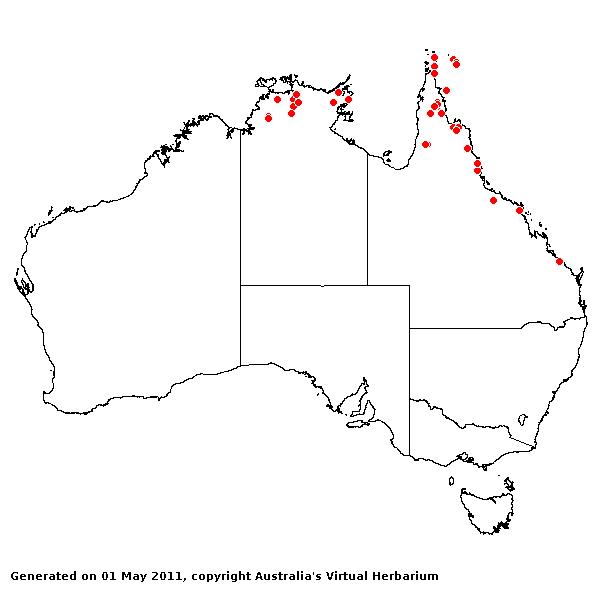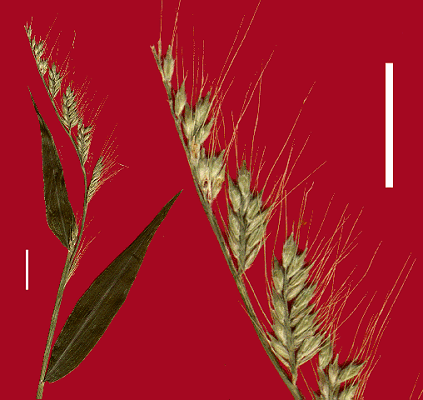Oplismenus burmannii (Retz.) P.Beauv. Ess.
Agrost. 54, 168, 169 (1812).
Classification. (GPWG 2001) : Subfamily
Panicoideae. Paniceae.
Basionym and/or
Replacement Name: Panicum
burmannii Retz., Observ. Bot. 3: 10 (1783).
Type of Basionym or
Protologue Information: HT: Koenig s.n., India: Madras (LD; IT: BM
(4 sheets), C).
Key references
(books and floras): [2002] D.Sharp & B.K.Simon, AusGrass, Grasses of
Australia, [2008] S.W.L.Jacobs, R.D.B.Walley & D.J.B.Wheeler, Grasses
of New South Wales.
Habit. Annual.
Culms prostrate, 10–60 cm tall. Mid-culm nodes glabrous. Ligule a fringed
membrane, a ciliate membrane, 0.4–0.8 mm long. Leaf-blades lanceolate or ovate,
1–10 cm long, 5–20 mm wide. Leaf-blade surface smooth.
Inflorescence.
Inflorescence compound, a panicle of racemes. Racemes 3–8, 0.5–2.5 cm long.
Central inflorescence axis 2–13 cm long.
Spikelets.
Spikelets sessile and pedicelled, 2 in the cluster. Fertile spikelets
2-flowered, the lower floret barren (rarely male), the upper fertile,
comprising 1 basal sterile florets, comprising 1 fertile floret(s), without
rachilla extension, lanceolate, laterally compressed, 2–3 mm long.
Glumes. Glumes
similar or dissimilar, thinner than fertile lemma. Lower glume ovate,
herbaceous, keeled, 1-keeled, 3–5 -nerved. Lower glume surface indumented.
Lower glume apex awned. Upper glume ovate, 1.7–2.2 mm long, herbaceous, keeled,
1-keeled, 3–7 -nerved. Upper glume surface indumented. Upper glume apex
muticous or awned. Florets. Basal sterile florets 1, barren, with palea
or without significant palea. Lemma of lower sterile floret 100 % of length of
spikelet, membranous, 1-keeled, 7–11 -nerved, mucronate or awned.
Fertile lemma 2–2.7 mm
long, without keel, 7 -nerved. Palea without keels.
Continental
Distribution: Africa, Temperate Asia, Tropical Asia, Australasia, Pacific,
North America, and South America.
Australian
Distribution: Northern Territory, Queensland.
Northern Territory:
Darwin & Gulf. Queensland: Cook, North Kennedy.
Notes.
Diagnostic features include the scabrous awns.
Native to the tropics,
occurring mainly in Africa and Asia. In tropical and subtropical sub-humid
woodlands and coastal grasslands. In Australia, it is known from relatively few
collections. Flowers Mar.-Aug.



